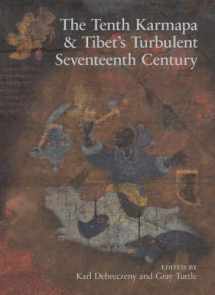
The Tenth Karmapa & Tibet's Turbulent Seventeenth Century
ISBN-13:
9781932476811
ISBN-10:
1932476814
Edition:
UK ed.
Author:
Gray Tuttle, Karl Debreczeny
Publication date:
2016
Publisher:
Serindia Publications
Format:
Hardcover
308 pages
FREE US shipping
Book details
ISBN-13:
9781932476811
ISBN-10:
1932476814
Edition:
UK ed.
Author:
Gray Tuttle, Karl Debreczeny
Publication date:
2016
Publisher:
Serindia Publications
Format:
Hardcover
308 pages
Summary
The Tenth Karmapa & Tibet's Turbulent Seventeenth Century (ISBN-13: 9781932476811 and ISBN-10: 1932476814), written by authors
Gray Tuttle, Karl Debreczeny, was published by Serindia Publications in 2016.
With an overall rating of 4.5 stars, it's a notable title among other
books. You can easily purchase or rent The Tenth Karmapa & Tibet's Turbulent Seventeenth Century (Hardcover) from BooksRun,
along with many other new and used
books
and textbooks.
And, if you're looking to sell your copy, our current buyback offer is $0.32.
Description
The Tenth Karmapa Chöying Dorjé (1604 1674) was both a famous artist and leader of the Karma Kagyu School of Tibetan Buddhism during a formative period in Tibetan history. The religious and institutional shape of modern Tibet was decided in the turbulent conflicts and dramatic reorganization of Tibetan society in the seventeenth century. With Mongol support, the Fifth Dalai Lama took control of Central Tibet and projected Gelukpa power far beyond Lhasa. As is often seen in the writing of history, the victor exerts its authority in its telling. Thus the preceding ruling polity and its leading lama, the Tenth Karmapa, have often been neglected. Chöying Dorjé's life is well documented in Tibetan sources which provide an alternative historical narrative of the tumultuous seventeenth century. This publication brings together specialists in literature, history, religion, and art to discuss the historical context of this seminal Tibetan figure, situating him and his life's work within the juncture of history, art and civilization, and Tibet's place in the larger world of the seventeenth century.


We would LOVE it if you could help us and other readers by reviewing the book
Book review

Congratulations! We have received your book review.
{user}
{createdAt}
by {truncated_author}


